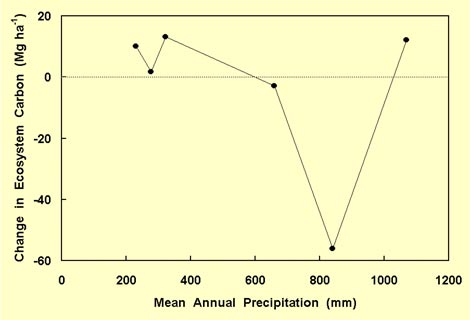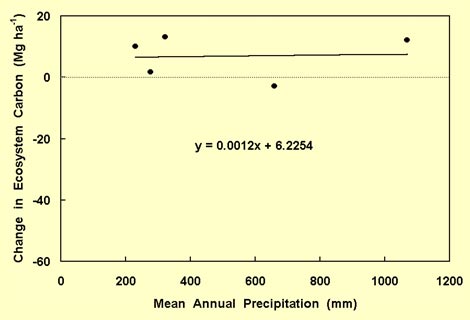Volume 5, Number 34: 21 August 2002
In their comprehensive study of U.S. carbon sinks, Pacala et al. (2001) list "woody encroachment" upon grasslands as one of the major repositories for atmospheric carbon in the coterminous United States. Their analysis of the subject suggests this phenomenon accounted for the sequestration of something on the order of 0.12 Pg C yr-1 (0.12 x 1015 grams of carbon per year) over the decade 1980-1990. In addition, it reconciles previous disparate estimates provided by atmospheric- and land-based methods of carbon accounting. Now, however, in a study of soil and plant carbon contents of pristine grasslands and adjacent grasslands that have been experiencing invasions of woody shrubs over the past 30-100 years, Jackson et al. (2002) claim this landscape-altering phenomenon has been greatly overrated as a carbon sink and, therefore, as a means of slowing the rate of rise of the air's CO2 content and reducing the potential for global warming.
Although disturbing in its implications and running counter to the conclusions of much earlier work, many people seem to be embracing this assessment of the issue without critically examining the data that are used to support it. Hence, we here review exactly what it was that Jackson et al. did and what we think their data do - and do not - imply.
The first part of Jackson et al.'s paper deals with two grand-average linear relationships - one for grasslands and one for woodlands - which they derived for total soil organic carbon (SOC) content vs. mean annual precipitation. Developed from thousands of measurements from all around the world, these relationships indicate, in their words, that "whereas grassland SOC [is] statistically indistinguishable from values for woody plants at 200 mm mean annual precipitation, woodlands [have] 43% less total SOC than grasslands at 1,000 mm," which seems to suggest that soil organic carbon content would indeed decline if a high-precipitation-region grassland was converted into woodland.
This analysis, however, is somewhat misleading; for it does not really deal with total SOC, as can be verified by checking the Supplementary Information cited by Jackson et al. In fact, it only deals with the organic carbon content of the upper one meter of the soil profile; and it is a well-known fact that the roots of woody plants often extend far below that depth and that they typically penetrate much deeper into the soil than do the roots of grasses. Integrated over the entire soil profile, therefore, the difference in SOC between grassland and woodland soils in high-precipitation regions would be expected to be less than what is implied by the relationships derived by Jackson et al. And who knows but what the difference might disappear altogether in some instances? In any event, Jackson et al. openly admit that this first analysis of theirs "lacked a direct test of vegetation change independent of other covarying factors," so they go on to examine "the direct effect of vegetation change at six paired grassland and invaded woody sites along a rainfall gradient in the southwestern USA, testing relationships of biomass C gains and SOC losses."
This latter statement reveals another important shortcoming of Jackson et al.'s first analysis: it only deals with soil organic carbon and does not include the carbon sequestered within plant biomass. So when the scientists made their second more germane comparison, which included changes in plant biomass carbon as well as soil carbon, what did they find?
As reported by Environment News Service's Cat Lazaroff on 8 August 2002, the study revealed that "in wet locations, the extra carbon saved in the wood of encroaching trees and shrubs was more than offset by the carbon lost from the underlying soil." Likewise, the News Service of Duke University (which employed three of the study's five authors) reported that "losses of 'organic' soil carbon at the wetter sites were 'substantial enough' to offset the increased 'plant biomass' carbon stored in the growing wood." This was also the take-home message of the paper itself, wherein the authors state that "losses of soil organic carbon at the wetter sites were substantial enough to offset increases in plant biomass carbon." In addition, the editors of Nature hyped the paper by saying that "at the wetter sites there was substantial loss of organic carbon from the soil, more than enough to offset increases in plant biomass carbon." Case closed, right? Wrong. These simple statements of purported facts are simply not true; in fact, they are just plain false.
Consider Figure 1 below, which we have constructed from data contained in the Jackson et al. paper. This presentation clearly indicates that the wettest site of all does not exhibit an invasion-induced loss of total plant and soil carbon; it exhibits an increase. In fact, it exhibits a greater invasion-induced increase in total plant and soil carbon (12.2 Mg ha-1) than the mean increase of the three driest sites (8.3 Mg ha-1), which sites receive so little annual precipitation they are described by Jackson et al. as "desert sites."

Figure 1. The net change in total ecosystem carbon content (plant plus soil) caused by invasion of woody species vs. mean annual precipitation, as derived from Table 2 of Jackson et al. (2002).
But how could the total carbon content of the wettest ecosystem rise with the invasion of woody plants? It could do so because the invasion-induced gain of plant carbon (44.4 Mg ha-1) was greater than the invasion-induced loss of soil carbon (32.2 Mg ha-1), in direct contradiction of the matter-of-fact but false statements of the ENS reporter, the Duke University News Service, the study's authors and the editors of Nature, all of whom falsely claimed that the loss of soil carbon is greater than the gain of plant carbon at the wetter sites.
So what is the ultimate truth of the matter? Do high-precipitation-region grasslands lose carbon or gain carbon when they are invaded by woody species? Given the amount and nature of the data presented in the paper of Jackson et al., it is impossible to know for sure. Nevertheless, we can do some things to help us make a much better educated guess than that of their analysis.
For starters, one of the six data points of Figure 1 is just not compatible with the other five. But which one is it? The authors of the paper, the reviewers of the paper, the editors of Nature, the ENS science reporter, and the Duke University News Service all made their choice when they decided to ignore the data point from the wettest region. We, on the other hand, feel that an even better case can be made for ignoring the data point from the next wettest region, i.e., the region with a mean annual precipitation of 840 mm, for the following reasons.
First, the authors of the paper, even now, apparently have no idea why their data behave as they claim they behave. In the Duke University News Service press release, for example, Jackson is reported to have said that "why this precipitation-tied carbon loss is occurring is still unclear" and "we don't know the exact mechanism yet." Hence, lacking a mechanistic hypothesis, even after the data have been collected and analyzed, the null hypothesis of no effect of mean annual precipitation on ecosystem carbon content should be one's starting point; and deleting the 840-mm precipitation data point produces a result that is in total harmony with this hypothesis, as shown in Figure 2 below, i.e., the slope of the linear regression line that describes the remaining five data points is not significantly different from zero, rising by only 1 Mg ha-1 over the entire range of mean annual precipitation investigated.

Figure 2. The net change in total ecosystem carbon content (plant plus soil) caused by invasion of woody species vs. mean annual precipitation, when the 840-mm mean annual precipitation data point is deleted from consideration.
Second, averaging the woody-plant invasion-induced changes in ecosystem total carbon content for the five precipitation regimes of Figure 2 (the four driest plus the wettest), the mean change in carbon content is determined to be 6.9 Mg ha-1 with a standard error of ± 3.2 Mg ha-1. And these figures indicate that the data point we ignore differs from the mean of the other five data points by twenty times more than their standard error ... which is what we call a really aberrant data point!
On this basis, it would appear that woody plants that invade grasslands enhance the total carbon contents of their new territories to roughly the same extent, irrespective of the total amount of annual precipitation they receive. However, yet another incredible shortcoming of the Jackson et al. study likely alters even this conclusion; and that shortcoming is their failure, believe it or not, to include one of the major biomass components of the invading woody plants in their analysis.
Although Jackson et al. measured representative samples of woody-plant fine-root biomass, they neither measured nor accounted for the biomass of the woody plants' large roots, which comprise a substantial portion of the total biomass of all such plants. Had they done so, the three low-precipitation ecosystems with a mean invasion-induced plant carbon increase of only 0.7 Mg ha-1 would have had their total carbon content enhancement increased by a rather small amount. The medium-precipitation ecosystem with an invasion-induced plant carbon increase of 4.7 Mg ha-1, on the other hand, would have had its total carbon content enhancement increased by a significantly larger amount, while the final high-precipitation ecosystem with an invasion-induced plant carbon increase of 44.4 Mg ha-1 would have had its total carbon content enhancement increased by a much greater amount. And these large-root carbon additions would likely have significantly altered the linear regression line of Figure 2, giving it a much greater positive slope.
In light of these several observations, we tentatively conclude - in diametric opposition to the conclusions of Jackson et al. - that woody-plant invasions of grasslands likely lead to increases in ecosystem total carbon content in nearly all situations, especially in high-precipitation regions, and that the magnitude of the invasion-induced carbon content increase is likely a monotonically increasing function of mean annual precipitation.
|
Dr. Sherwood B. Idso President |
Dr. Keith E. Idso Vice President |
References
Jackson, R.B., Banner, J.L., Jobbagy, E.G., Pockman, W.T. and Wall, D.H. 2002. Ecosystem carbon loss with woody plant invasion of grasslands. Nature 418: 623-626.
Pacala, S.W., Hurtt, G.C., Baker, D., Peylin, P., Houghton, R.A., Birdsey, R.A., Heath, L., Sundquist, E.T., Stallard, R.F., Ciais, P., Moorcroft, P., Caspersen, J.P., Shevliakova, E., Moore, B., Kohlmaier, G., Holland, E. Gloor, M., Harmon, M.E., Fan, S.-M., Sarmiento, J.L., Goodale, C.L., Schimel, D. and Field, C.B. 2001. Consistent land- and atmosphere-based U.S. carbon sink estimates. Science 292: 2316-2320.




